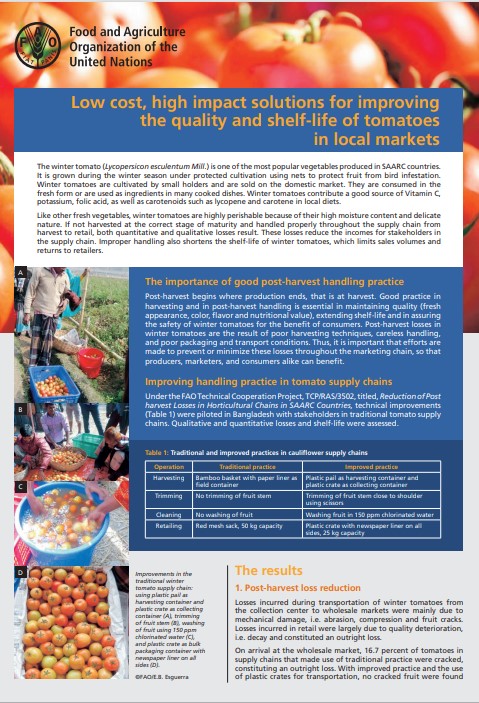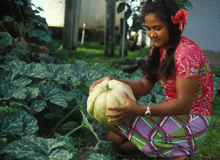Fruits and vegetables Publications

Low cost, high impact solutions for improving the quality and shelf-life of snap beans in local markets
28/02/2018
Snap beans (Phaseolus vulgaris L.) are among the most important vegetables produced in SAARC countries. They are mainly grown by smallholders and are marketed domestically. As a vegetable, snap beans are high in protein and soluble fiber and low in calories.

Low cost, high impact solutions for improving the quality and shelf-life of tomatoes in local markets
28/02/2018
The winter tomato (Lycopersicon esculentum Mill.) is one of the most popular vegetables produced in SAARC countries. It is grown during the winter season under protected cultivation using nets to protect fruit from bird infestation. Winter tomatoes are cultivated by small holders and are sold on the domestic market. They are consumed in the fresh form or are used as ingredients in many cooked dishes.

Low cost, high impact solutions for improving the quality and shelf-life of bananas in local markets
28/02/2018
Banana (Musa sapientum) is one of the leading fruit crops produced in SAARC countries. Bananas are popularly consumed both in the fresh and cooked forms. Bananas are a rich source of carbohydrate and vitamins and particularly vitamin A. They are also a rich source of potassium, phosphorous calcium and magnesium. Banana production and marketing offers many economic opportunities in the region, and particularly for smallholder farmers.

Post-harvest management of banana for quality and safety assurance
28/02/2018
Guidance for horticultural supply chain stakeholders. Bananas are grown in Timor-Leste for their economic and nutritional value. A number of banana cultivars are produced by smallholder farmers mainly for domestic consumption. Ripened bananas are consumed as dessert fruit. Immature or green bananas are consumed in the cooked state and are processed into chips. Bananas provide a good source of energy.

Post-harvest management of snap bean for quality and safety assurance
28/02/2018
Guidance for horticultural supply chain stakeholders. Snap bean (Phaseolus vulgaris L.) ranks 6th as the most demanded vegetable in Sri Lanka. It is produced mostly on small farms. The peak harvest seasons for snap beans are March – April and September – December.

Post-harvest management of mango for quality and safety assurance
28/02/2018
Guidance for horticultural supply chain stakeholders Mango is one of the most important and popular fruits in Bangladesh and is referred to as the “king of fruits” because of its excellent overall eating characteristics. It is consumed as a fresh fruit, in the frozen, preserved or dried forms or is processed into juices, purees, chutneys and pickles. Ripe mangoes are best eaten as fresh fruit, usually as a dessert and are used in the production of confectionery, ice cream, and bakery products.

Low cost, high impact solutions for improving the quality and shelf-life of mandarins in local markets
28/02/2018
Mandarin (Citrus reticulate Blanco) is an important fruit crop grown in SAARC countries. Almost all mandarin fruits are marketed domestically, although small volumes are exported by producing countries to other countries within and outside the region. Known for its excellent flavor and nutritional value, the easy-to-peel fruit is commonly consumed in the fresh form or in fruit salad preparations as well as in the form of fresh juice.

Post-harvest management of cauliflower for quality and safety assurance
28/02/2018
Guidance for horticultural supply chain stakeholders. Cauliflower (Brassica oleracea var. botrytis) is a cash crop and the number one vegetable crop in terms of production and value in Nepal. The popularity and high consumer demand for cauliflower stem from its nutritional quality and health benefits. Cauliflower contains high levels of Vitamins C and B, calcium (Ca), Iron (Fe) and phosphorus (P) and is known to have health promoting benefits.

Low cost, high impact solutions for improving the quality and shelf-life of cauliflowers in local markets
28/02/2018
Cauliflower (Brassica oleracea var. botrytis) is a cash crop and is one of the most widely consumed vegetables in SAARC countries. It is consumed for its nutritional value and health benefit. Cauliflower is rich in nutrients and in phytochemicals (glucosinolates) that can lower the risk of cancer and cardiovascular diseases. Aside from its nutritional value, cauliflower production and marketing offer many economic opportunities in the region especially for smallholder farmers.

Low cost, high impact solutions for improving the quality and shelf-life of mangoes in local markets
28/02/2018
Mango (Mangifera indica L.) is one of the most important fruit crops produced in SAARC countries. The fruit has excellent overall eating characteristics. Ripe mangoes are consumed in the fresh form and are used as ingredients in the preparation of confectionery, ice cream, sherbets, and bakery products.

Post-harvest management of tomato for quality and safety assurance
20/02/2018
Guidance for horticultural supply chain stakeholders. Tomato (Lycopersicon esculentum Mill.) is a vegetable crop popularly consumed in Bangladesh. It is commonly used for table consumption in fresh form or as an ingredient in many cooked dishes.
.jpg?sfvrsn=73ca5129_1)
Food loss assessment of cassava, tomato and potato value chains in Cameroon (in French)
01/01/2018
L’initiative Save Food a conçu des études de cas sur les chaînes d’approvisionnement alimentaire pour les principaux sous-secteurs alimentaires des pays en voie de développement. Ces études de cas permettront de générer des données primaires et empiriques sur les différentes causes de perte alimentaire, et d’analyser la faisabilité des différentes...

Value-adding for Samoan fruit and vegetable market vendors: Waste less and sell more
01/01/2018
While tropical fruits represent less than 20% of the net horticultural productivity in the South Pacific, they experience disproportionally high levels of postharvest loss. Much of this loss is concentrated at the market-end of the value chain. Inter-island fruit value chains and hose associated with transient and opportunistic fruit harvesting.

How to Determine the Potential to Increase Vegetable Yield Through Estimating and Reducing Field Losses
01/01/2018
Vegetable growers can use many strategies to increase quality and yield. To boost productivity, they can optimize fertilization, irrigation, and pest and disease management, and they can plant improved varieties. An often overlooked method is to reduce field loss, which can amount to a significant portion of the harvested yield.

Case studies on managing quality, assuring safety and reducing post-harvest losses in fruit and vegetable supply chains in South Asian Countries
01/01/2018
Fresh fruits and vegetables contribute significantly to food and nutrition security, poverty reduction and to economic development in the countries belonging to the South Asian Association for Regional Cooperation (SAARC). Smallholders who make little use of post-harvest technologies produce most of the fresh fruits and vegetables supplied to mass markets.

The Reality of Food Losses. A New Measurement Methodology
01/12/2017
Despite the presumed importance of food loss, figures regarding food loss remain highly inconsistent, precise causes of food loss remain undetected, and success stories of decreasing food loss remain few. We improve over this measurement gap on food losses by developing and testing the methodology traditionally used with three new methodologies that aim to reduce the measurement error and that allow us to assess the magnitude of food loss.

Policy Measures for managing quality and reducing postharvest losses in fresh produce supply chain in South Asian countries.
01/10/2017
Smallholders and traders are key stakeholders in fruit and vegetable supply chains supplying local mass markets across South Asian countries. Training these stakeholders and introducing simple technical innovations into these supply chains can dramatically improve the quality and shelf-life of fresh produce and reduce losses, thereby generating economic benefits for...

Reducing post-harvest losses in fruits and vegetables in South Asian countries
30/06/2017
An FAO project aimed to pilot the implementation of good post-harvest management practices to manage quality, assure safety and reduce losses in prioritized traditional fruit and vegetable supply chains with stakeholders, in order to generate evidence to support the uptake of the improved practices.

Postharvest losses of perishables in Brazil: what do we know so far?
01/01/2017
Although difficult to pin down an exact figure, the idea that postharvest losses (PHL) of perishables in Brazil stand at 30-45% has been widely accepted. In spite of the modernization of production systems and the logistics and distribution of perishables in the last decades, postharvest losses continue to be a...

Food losses and waste: how Brazil is facing this global challenge?
01/01/2017
By 2017, Brazil seems to have finally awakened to the problem of food loss and waste. In this article, we resume the topic started in the article “Postharvest losses of perishables in Brazil: what do we know so far?”
